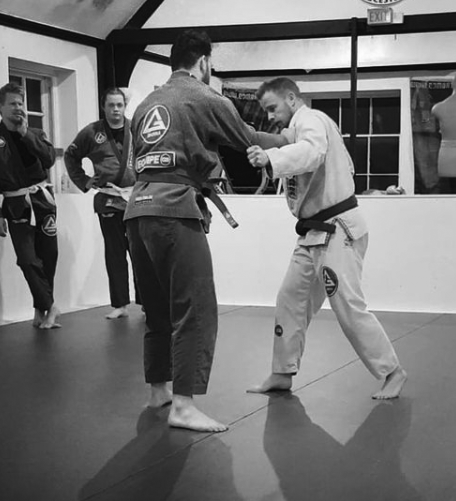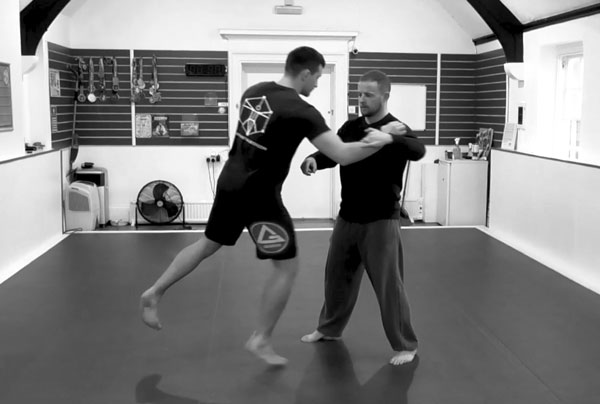The opponent does not know me;
I alone know him.
To become a peerless boxer results from this.
In this fascinating verse, we see the idea of hiding ourselves from our opponent while simultaneously understanding what they wish to do, clearly a useful skill to have. In this edition of unpacking the classics we will dive into this subject to discover the ways in which the our own structure can hide us from the listening skill of our opponent, while simultaneously giving us access to them.
 The opponent does not know me
The opponent does not know me
In many martial arts it is important to be able to touch the opponent without them realising where we wish to go, what we want to do or where our power is coming from. Many martial arts rely on this ability to feel the opponents force, for instance it can be seen in competitive arts like judo where the ability to off-balance (kuzushi) is often related to understanding where the opponents strength is. The exponent of arts like judo will often grip explicitly to discover the weaknesses in your structure, so that they can take advantage of them.
When we use the more standard or natural body method and work within normal ranges of strength or movement it is very difficult for us to hide ourselves from our opponent. Our natural reaction betrays us and we soon become subject to their tactical or strategic approaches. Happily, Tai Chi and the development of the qualities of the Internal Arts body gives us an opportunity to negate or lessen the effect of an opponents actions, such that they may find it much more difficult to feel what is going on.
Faraday cage concept
A part of this process is the development of what I call the ‘faraday cage concept’. I coined this term decades ago while teaching the art of Xing Yi to describe the way in which the correctly trained body can route power around the centre. A faraday cage is a structure that allows electricity to pass around its surface protecting whatever lies within. For instance, a car is a faraday cage and if struck by lightning, if you are inside the car, is likely you will remain unhurt.
In the body this concept relates to the development of a type of suit of tissue, which is able to pass force around the exterior of our body directly to the Earth with it never touching or impacting our centre. The process of developing this skill is one of tissue development, coordination, harmonisation and angulation. We must first develop the tissues in question such that they are interlinked and work in harmony with one another. Once this linking of the tissues is achieved we must train to be able to freely and spontaneously create angles to the opponents force so that they are never truly pushing directly into our centre. The combination of these two factors come together to develop the faraday cage concept enabling us to avoid the problem of force on force or force hitting our centre.
It is, however, the result of a huge amount of training, not only in the development of the body but also in the development of our ability to listen to the opponents force and freely angulate so that we do not meet it head-on. This is no small feat as we must over ride our natural inclination to oppose incoming forces. Only when this natural propensity is diminished can the Faraday Cage concept really come into its own.
 Hiding our centre from their directions
Hiding our centre from their directions
The primary role in the faraday cage concept is to hide our centre from the forces that the opponent wishes to apply. It ids often the case, during natural reaction, that we form up behind the opponents force, and therefore present our centre to them. This, in turn allows them to manipulate our centre of mass in any way they wish, resulting in throws, trips, take downs or worse. To avoid this, in tai chi we must attempt to hide our centre from our opponent. The objective here is to naturally and spontaneously never giving them access, so that they are unable to enact their will.
Although the primary method of hiding our centre can be found in the faraday cage concept, it is also true that stepping and avoidance through movement can also hide our centre. A slight step to create an angle or a large retreat to escape entirely, will often be enough to hide the centre. Then when combining this with the faraday cage concept of angulation and directing forces around the surface of our body we are able to become illusion and hidden from our partner.
Listening skills
So we can see that hiding ourselves is one important part of the equation here. But secondly we must ‘know the opponent’, otherwise we will simply be hidden in a never ending game of cat and mouse. The key to this ability to know the opponent is also found in the faraday cage idea.
The development of the body such that it can work in harmony to redirect forces, has the secondary advantage that it develops the bodies sensitivity. Sensitivity to direction, force, and movement is what allows the instantaneous angulation of the point of contact. It is also the gateway to understanding the opponent. As we engage with them, we feel precisely what they are trying to do, even if they are unable to do it. This is the listening skill of tai chi (ting) and allows us to find the gaps, holes and deficiencies in the opponents offence such that we may be able to exploit them.
 The turning wheel and tangential force
The turning wheel and tangential force
Next we have the concept of turning like a wheel and creating tangential force. This concept completely avoids the entering of the opponents forces. Instead the opponent touches a turning structure that they are then caught up on, and therefore must deal with. The opponent never gets the direction that they want, instead they must change their angle to try to gain the advantageous line. Unfortunately for the opponent the point of contact continues to change and they never gain the advantage. This change in direction can then be used to capture the opponent as they attempt to capture you and so the force amounts to nothing.
It must be said that it is very easy to think of this process in large terms, moving in a large circular fashion, wheeling the arms or the torso around. But actually this idea of rotation and tangential force can happen with in the limb or directly under the contact point. As this tiny change or adjustment happens the opponent will feel that their power diminishes because the angle that they require for the power to be affective is no longer present. So, they adjust their power, to try to cater for this change and it is in that adjustment that we are able to capture the movement and lead them as we see fit.
Conclusion
And so we see that the concept of knowing the opponent without them knowing us can be applied directly to the mechanical principles that tai chi aims to expunge. We begin with the ability to hide our own centre and this in turn can give rise to our ability to find our partners. This is a process of self development more than it is a process of applying tactics. Without the faraday cage concept, without the natural ability to produce angles, to listen or to move like a turning wheel, none of this is possible. And so, once again, it comes down to practice.